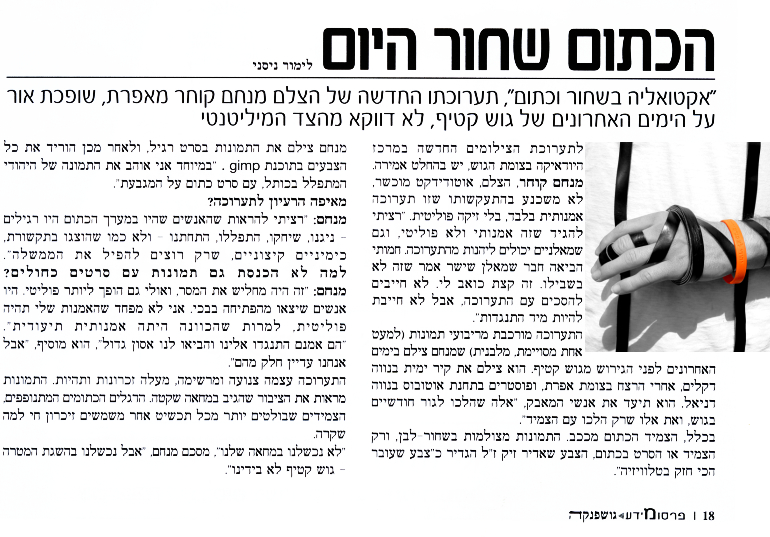Menachem Kuchar
Photographer

|
Today the Orange Has Turned Black Actualities in Black & Orange, the new exhibition by photographer Menachem Kuchar from Efrat, sheds light on the latter days of Gush Katif, and not necessarily from a militant point of view. The new exhibition of photographs at the Gush Etzion Judaica Centre certainly makes a statement. Menachem Kuchar, photographer, self-taught and talented, is not completely convinced himself when he says that this is an exhibition of fine art only and is not politically tainted. "I wanted to say that this is art and not politics, and that left-wingers can also enjoy the exhibition. My mother-in-law brought a left-wing friend [to the opening]; he immediately said that this was not for him. That hurts me somewhat. You don't have to agree with the exhibition , but by the same token you don't have to immediately react against it." The photographs presented in the exhibition are all square (except for a specific one that is oblong) and were taken in the last days before the expulsion from Gush Katif. He photographed the Yamit Wall in Neve Dekalim, at the turn-off to Efrat following a drive-by murder in Gush Etzion, posters pasted to a bus stop at Neve Daniel. He has documented the people behind the struggle, "those that went to live in the Gush [Katif], and those that wore an orange bracelet". Overall, the orange bracelet is the star of the show. The photographs are all black and white -- just the bracelet or the ribbon are featured in orange, the colour that the late Adir Zik emphasised as "the colour that stands out the most on television". Menachem photographs the photographs on colour and later on desaturated the colours using a program called the Gimp. "I especially like the photograph of the person praying at the Kotel (Western Wall), with an orange ribbon around his hat". From where did the idea of the exhibition originate? Menachem: "I wanted to show that the people behind the orange campaign were regular people -- the play music, they play games, they pray, get married -- and not as they were portrayed by the press: right-wing extremists trying to bring down the government". Why didn't you also include pictures of blue ribbons? Menachem: "This would have reduced the power of the message, and perhaps make the collect even more political. Some people left the opening [night of the exhibition] in tears. I'm not afraid that my art is interpreted as political, even though my aim was documentary art". "They were in fact against us, and brought about a great tragedy", he said, "but we are still a pert of them". The exhibition itself is modest, but impressive. bringing up memories and realities. The photographs show population that silently protested. The orange flags flying in the breeze, the bracelet that stands out more than other jewellery on a wrist, a living memorial to that which occurred. "We did not fail in out protest", Menachem summarises, "but we did fail in achieving the real goal -- Gush Katif is no longer in our hands". Limor Nissani |